Spatiotemporal Variation and Driving Forces of Ecological Security Based on Ecosystem Health, Services, and Risk in Tianjin, China
Abstract
1. Introduction
2. Materials and Methods
2.1. Study Area
2.2. Data Sources
2.3. Assessing Land Use Change
2.4. Integrated Framework for Assessing Ecological Security
2.4.1. Ecosystem Health
2.4.2. Ecosystem Services
2.4.3. Ecological Risk
2.5. Optimal Parameter Geo-Detector Model
2.6. Data Analysis
3. Results
3.1. Variations in Land Use Transfer
3.2. Integrated Assessment of Ecosystem Health, Ecosystem Services, and Ecological Risk
3.3. Spatial and Temporal Changes in Ecological Security
3.4. Driving Mechanism of Ecological Security
3.4.1. Single-Factor Analysis
3.4.2. Detection of Factor Interactions
4. Discussion
4.1. Comparison of Ecological Security Assessment Results in Tianjin
4.2. Driving Forces of Ecological Security
4.3. Limitations and Future Research Direction
5. Conclusions
- (1)
- Construction land was the primary land use type that increased, with cropland, water body, and unutilized land showing decreasing trends during the study period, while woodland and grassland exhibited minimal net change.
- (2)
- Tianjin’s ecosystem health level was dominated by the general level and above, accounting for more than 53.57% of the total area. The sum of the areas with better- and high-quality ecosystem service levels in Tianjin showed a decreasing and then an increasing trend. The proportions of relatively lower- and low-risk areas were more significant, and the proportion of these areas showed a gradual upward trend.
- (3)
- The Tianjin ecological security index showed a slight upward trend from 2012 to 2022. Ecological security levels were dominated by medium, medium-high, and high security, with the area of medium and high security levels increasing. In contrast, the area of medium-high ecological security levels decreased, gradually transforming into medium- and medium-high security levels. Changes in ecological security were more stable and dominated by areas with unchanged levels, accounting for 63.72% of the total area.
- (4)
- The SHDI, SHEI, vegetation type, elevation, and mean annual temperature were the main factors affecting Tianjin’s ecological security change. Among them, the interaction of SHDI and vegetation type had the most significant effect on the ecological security of Tianjin.
Supplementary Materials
Author Contributions
Funding
Institutional Review Board Statement
Informed Consent Statement
Data Availability Statement
Conflicts of Interest
References
- Pecl, G.T.; Araújo, M.B.; Bell, J.D.; Blanchard, J.; Bonebrake, T.C.; Chen, I.-C.; Clark, T.D.; Colwell, R.K.; Danielsen, F.; Evengård, B.; et al. Biodiversity Redistribution under Climate Change: Impacts on Ecosystems and Human Well-Being. Science 2017, 355, eaai9214. [Google Scholar] [CrossRef] [PubMed]
- Santos de Lima, L.; Magalhães de Oliveira, H.F.; Fleischmann, A.S.; Macedo, M.N. Extreme Drought Is Again Isolating People in Amazonia. Nature 2023, 622, 697. [Google Scholar] [PubMed]
- Manca, F.; Benedetti-Cecchi, L.; Bradshaw, C.J.A.; Cabeza, M.; Gustafsson, C.; Norkko, A.M.; Roslin, T.V.; Thomas, D.N.; White, L.; Strona, G. Projected Loss of Brown Macroalgae and Seagrasses with Global Environmental Change. Nat. Commun. 2024, 15, 5344. [Google Scholar] [CrossRef] [PubMed]
- Bi, M.; Xie, G.; Yao, C. Ecological Security Assessment Based on the Renewable Ecological Footprint in the Guangdong-Hong Kong-Macao Greater Bay Area, China. Ecol. Indic. 2020, 116, 106432. [Google Scholar] [CrossRef]
- Wu, X.; Liu, S.; Sun, Y.; An, Y.; Dong, S.; Liu, G. Ecological Security Evaluation Based on Entropy Matter-Element Model: A Case Study of Kunming City, Southwest China. Ecol. Indic. 2019, 102, 469–478. [Google Scholar] [CrossRef]
- Xue, Q.; Zhang, Y.; Zhang, Q.; Wu, Q.; Zhang, X.; Lu, L.; Qin, C. Towards Ecological Security: Two-Thirds of China’s Ecoregions Experienced a Decline in Habitat Quality from 1992 to 2020. Ecol. Indic. 2025, 172, 113275. [Google Scholar] [CrossRef]
- Liu, C.; Li, W.; Xu, J.; Zhou, H.; Li, C.; Wang, W. Global Trends and Characteristics of Ecological Security Research in the Early 21st Century: A Literature Review and Bibliometric Analysis. Ecol. Indic. 2022, 137, 108734. [Google Scholar] [CrossRef]
- Hodson, M.; Marvin, S. ‘Urban Ecological Security’: A New Urban Paradigm? Int. J. Urban Reg. Res. 2009, 33, 193–215. [Google Scholar] [CrossRef]
- Su, Y.; Chen, X.; Liao, J.; Zhang, H.; Wang, C.; Ye, Y.; Wang, Y. Modeling the Optimal Ecological Security Pattern for Guiding the Urban Constructed Land Expansions. Urban For. Urban Green. 2016, 19, 35–46. [Google Scholar] [CrossRef]
- Zhu, B.; Hashimoto, S.; Cushman, S.A. Navigating Ecological Security Research over the Last 30 Years: A Scoping Review. Sustain. Sci. 2023, 18, 2485–2498. [Google Scholar] [CrossRef]
- Jing, P.; Sheng, J.; Wang, Y.; Hu, T.; Guo, L.; Zhu, R.; Dong, K.; Mahmoud, A.; Liu, Y.; Li, X. Assessing the Ecological Security of the Three Gorges Reservoir Complex Ecosystem Based on the Improved Three-Dimensional Emergy Ecological Footprint Model. Sci. Total Environ. 2024, 933, 173086. [Google Scholar] [CrossRef]
- Wang, X.; Tang, X.; Shi, J.; Du, P. Construction and Optimization of Urban and Rural Ecological Security Patterns Based on Ecological Service Importance in a Semi-Arid Region: A Case Study of Lanzhou City. Sustainability 2024, 16, 6177. [Google Scholar] [CrossRef]
- Lu, T.; Li, C.; Zhou, W.; Liu, Y. Fuzzy Assessment of Ecological Security on the Qinghai–Tibet Plateau Based on Pressure–State–Response Framework. Remote Sens. 2023, 15, 1293. [Google Scholar] [CrossRef]
- Zhang, J.; Qiao, X.; Yang, Y.; Liu, L.; Li, Y.; Zhao, S. Ecological Security Driving Mechanisms and Optimization of Zoning in Chinese Urban Agglomerations: A Case Study of the Central Plains Urban Agglomeration. Ecol. Indic. 2025, 171, 113190. [Google Scholar] [CrossRef]
- Xiao, D.; Chen, W. On the Basic Concepts and Contents of Ecological Security. Chin. J. Appl. Ecol. 2002, 13, 354–358. [Google Scholar]
- Sun, M.; Zhang, L.; Yang, R.; Li, X.; Zhang, Y.; Lu, Y. Construction of an Integrated Framework for Assessing Ecological Security and Its Application in Southwest China. Ecol. Indic. 2023, 148, 110074. [Google Scholar] [CrossRef]
- Ma, X.; Wang, W.; Kang, Y.; Chen, J. Series of Two Transistors Forward ZVZCS Converter with Phase-Shifted Control for High Input Voltage. In Proceedings of the 30th Annual Conference of IEEE Industrial Electronics Society, IECON 2004, Busan, Republic of Korea, 2–6 November 2004; Volume 1, pp. 761–766. [Google Scholar]
- Xie, H.; He, Y.; Choi, Y.; Chen, Q.; Cheng, H. Warning of Negative Effects of Land-Use Changes on Ecological Security Based on GIS. Sci. Total Environ. 2020, 704, 135427. [Google Scholar] [CrossRef]
- Xie, B.; Jones, P.; Dwivedi, R.; Bao, L.; Liang, R. Evaluation, Comparison, and Unique Features of Ecological Security in Southwest China: A Case Study of Yunnan Province. Ecol. Indic. 2023, 153, 110453. [Google Scholar] [CrossRef]
- Zhao, L.; Ma, R.; Yang, Z.; Ning, K.; Chen, P.; Wu, J. Ecosystem Health Risk Assessment of Lakes in the Inner Mongolian Plateau Based on the Coupled AHP-SOM-CGT Model. Ecol. Indic. 2023, 156, 111168. [Google Scholar] [CrossRef]
- Yang, Y.; Cai, Z. Ecological Security Assessment of the Guanzhong Plain Urban Agglomeration Based on an Adapted Ecological Footprint Model. J. Clean Prod. 2020, 260, 120973. [Google Scholar] [CrossRef]
- Sun, M.; Li, X.; Yang, R.; Zhang, Y.; Zhang, L.; Song, Z.; Liu, Q.; Zhao, D. Comprehensive Partitions and Different Strategies Based on Ecological Security and Economic Development in Guizhou Province, China. J. Clean. Prod. 2020, 274, 122794. [Google Scholar] [CrossRef]
- Cheng, H.; Zhu, L.; Meng, J. Fuzzy Evaluation of the Ecological Security of Land Resources in Mainland China Based on the Pressure-State-Response Framework. Sci. Total Environ. 2022, 804, 150053. [Google Scholar] [CrossRef]
- Liu, Y.; Zhao, C.; Liu, X.; Chang, Y.; Wang, H.; Yang, J.; Yang, X.; Wei, Y. The Multi-Dimensional Perspective of Ecological Security Evaluation and Drive Mechanism for Baishuijiang National Nature Reserve, China. Ecol. Indic. 2021, 132, 108295. [Google Scholar] [CrossRef]
- Zhang, R.; Li, P.; Xu, L. Evaluation and Analysis of Ecological Security Based on the Improved Three-Dimensional Ecological Footprint in Shaanxi Province, China. Ecol. Indic. 2022, 144, 109483. [Google Scholar] [CrossRef]
- Li, Y.; Geng, H. Evolution of Land Use Landscape Patterns in Karst Watersheds of Guizhou Plateau and Its Ecological Security Evaluation. Land 2022, 11, 2225. [Google Scholar] [CrossRef]
- Wu, M.; Wei, Y.; Lam, P.T.I.; Liu, F.; Li, Y. Is Urban Development Ecologically Sustainable? Ecological Footprint Analysis and Prediction Based on a Modified Artificial Neural Network Model: A Case Study of Tianjin in China. J. Clean. Prod. 2019, 237, 117795. [Google Scholar] [CrossRef]
- Zhao, S.; Ma, Y.; Wang, J.; You, X. Landscape Pattern Analysis and Ecological Network Planning of Tianjin City. Urban For. Urban Green. 2019, 46, 126479. [Google Scholar] [CrossRef]
- Xue, M.; Luo, Y. Dynamic Variations in Ecosystem Service Value and Sustainability of Urban System: A Case Study for Tianjin City, China. Cities 2015, 46, 85–93. [Google Scholar] [CrossRef]
- Chen, X.; Kang, B.; Li, M.; Du, Z.; Zhang, L.; Li, H. Identification of Priority Areas for Territorial Ecological Conservation and Restoration Based on Ecological Networks: A Case Study of Tianjin City, China. Ecol. Indic. 2023, 146, 109809. [Google Scholar] [CrossRef]
- Guan, Q.; Chen, J.; Guan, C.; Li, H.; Zhou, X.; Meng, T. The Responses of Ecosystem Services in Coastal Cities to Urbanization in 30 Years: A Case Study of Qingdao City, China. Ocean Coast. Manag. 2024, 258, 107415. [Google Scholar] [CrossRef]
- Lv, W.; Xie, Y.; Zeng, P. Assessing and Predicting Spatiotemporal Alterations in Land-Use Carbon Emission and Its Implications to Carbon-Neutrality Target: A Case Study of Beijing-Tianjin-Hebei Region. Land 2024, 13, 2066. [Google Scholar] [CrossRef]
- Li, Q.; Li, D.; Wang, J.; Wang, S.; Wang, R.; Fu, G.; Yuan, Y.; Zheng, Z. Spatial Heterogeneity of Ecosystem Service Bundles and the Driving Factors in the Beijing-Tianjin-Hebei Region. J. Clean Prod. 2024, 479, 144006. [Google Scholar] [CrossRef]
- Gao, X.; Xie, Y.; Zou, Y.; Li, F.; Deng, Z.; Geng, M.; Zhang, P. Spatiotemporal Evolution and Driving Mechanisms of Land Use in Regions with Frequent Human–Land Interactions: A Case Study in the Dongting Lake Area. Sustainability 2025, 17, 1894. [Google Scholar] [CrossRef]
- Zhu, Q.; Cai, Y. Integrating Ecological Risk, Ecosystem Health, and Ecosystem Services for Assessing Regional Ecological Security and Its Driving Factors: Insights from a Large River Basin in China. Ecol. Indic. 2023, 155, 110954. [Google Scholar] [CrossRef]
- Wang, Y.; Yang, Z.; Yu, M.; Lin, R.; Zhu, L.; Bai, F. Integrating Ecosystem Health and Services for Assessing Ecological Risk and Its Response to Typical Land-Use Patterns in the Eco-Fragile Region, North China. Environ. Manag. 2023, 71, 867–884. [Google Scholar] [CrossRef]
- Jin, W.; Bian, Z.; Dong, Z.; Chen, D. Diagnosis of Ecological Security and the Spatial Heterogeneity of Its Driving Factors in the Mining-Impacted Watershed, Based on Ecosystem Health-Risk-Services Framework. Ecol. Indic. 2024, 167, 112683. [Google Scholar] [CrossRef]
- Liu, C.; Li, W.; Xu, J.; Zhou, H.; Wang, W.; Wang, H. Temporal and Spatial Variations of Ecological Security on the Northeastern Tibetan Plateau Integrating Ecosystem Health-Risk-Services Framework. Ecol. Indic. 2024, 158, 111365. [Google Scholar] [CrossRef]
- Fu, S.; Zhao, L.; Qiao, Z.; Sun, T.; Sun, M.; Hao, Y.; Hu, S.; Zhang, Y. Development of Ecosystem Health Assessment (EHA) and Application Method: A Review. Sustainability 2021, 13, 11838. [Google Scholar] [CrossRef]
- Yang, J.; Xin, Z.; Li, X.; Liang, X. Vigor–Organization–Resilience Framework for Assessing Ecosystem Health in the Qinghai–Xizang Plateau. Ecosyst. Health Sustain. 2024, 10, 0260. [Google Scholar] [CrossRef]
- Peng, J.; Liu, Y.; Wu, J.; Lv, H.; Hu, X. Linking Ecosystem Services and Landscape Patterns to Assess Urban Ecosystem Health: A Case Study in Shenzhen City, China. Landsc. Urban Plan. 2015, 143, 56–68. [Google Scholar] [CrossRef]
- Lei, D.; Zhang, Y.; Ran, Y.; Gao, L.; Li, J.; Li, Z.; Mo, J.; Liu, X. Assessment of Ecosystem Health Based on Landscape Pattern in Ecologically Fragile Regions at Different Spatial Scales: A Case Study of Dianchi Lake Basin, China. Front. Environ. Sci. 2023, 11, 1076344. [Google Scholar] [CrossRef]
- Lei, J.; Li, C.; Yang, W. Ecosystem Health Assessment and Approaches to Improve Sichuan Province Based on an Improved Vigor Organization Resilience Model. Ecol. Indic. 2023, 155, 110925. [Google Scholar] [CrossRef]
- Zhou, Y.; Yue, D.; Li, S.; Liang, G.; Chao, Z.; Zhao, Y.; Meng, X. Ecosystem Health Assessment in Debris Flow-Prone Areas: A Case Study of Bailong River Basin in China. J. Clean Prod. 2022, 357, 131887. [Google Scholar] [CrossRef]
- Xiao, R.; Liu, Y.; Fei, X.; Yu, W.; Zhang, Z.; Meng, Q. Ecosystem Health Assessment: A Comprehensive and Detailed Analysis of the Case Study in Coastal Metropolitan Region, Eastern China. Ecol. Indic. 2019, 98, 363–376. [Google Scholar] [CrossRef]
- Ashour, M.; Mahdiyar, A. A Comprehensive State-of-the-Art Survey on the Recent Modified and Hybrid Analytic Hierarchy Process Approaches. Appl. Soft. Comput. 2024, 150, 111014. [Google Scholar] [CrossRef]
- Liu, B.; Huang, J.J.; McBean, E.; Li, Y. Risk Assessment of Hybrid Rain Harvesting System and Other Small Drinking Water Supply Systems by Game Theory and Fuzzy Logic Modeling. Sci. Total Environ. 2020, 708, 134436. [Google Scholar] [CrossRef]
- Peng, J.; Zhang, J. Urban Flooding Risk Assessment Based on GIS- Game Theory Combination Weight: A Case Study of Zhengzhou City. Int. J. Disaster Risk Reduct. 2022, 77, 103080. [Google Scholar] [CrossRef]
- Lv, T.; Zeng, C.; Lin, C.; Liu, W.; Cheng, Y.; Li, Y. Towards an Integrated Approach for Land Spatial Ecological Restoration Zoning Based on Ecosystem Health Assessment. Ecol. Indic. 2023, 147, 110016. [Google Scholar] [CrossRef]
- Shen, W.; Li, Y.; Qin, Y. Research on the Influencing Factors and Multi-Scale Regulatory Pathway of Ecosystem Health: A Case Study in the Middle Reaches of the Yellow River, China. J. Clean Prod. 2023, 406, 137038. [Google Scholar] [CrossRef]
- Pan, Z.; He, J.; Liu, D.; Wang, J. Predicting the Joint Effects of Future Climate and Land Use Change on Ecosystem Health in the Middle Reaches of the Yangtze River Economic Belt, China. Appl. Geogr. 2020, 124, 102293. [Google Scholar] [CrossRef]
- Pan, Z.; He, J.; Liu, D.; Wang, J.; Guo, X. Ecosystem Health Assessment Based on Ecological Integrity and Ecosystem Services Demand in the Middle Reaches of the Yangtze River Economic Belt, China. Sci. Total Environ. 2021, 774, 144837. [Google Scholar] [CrossRef]
- Li, W.; Wang, Y.; Xie, S.; Cheng, X. Spatiotemporal Evolution Scenarios and the Coupling Analysis of Ecosystem Health with Land Use Change in Southwest China. Ecol. Eng. 2022, 179, 106607. [Google Scholar] [CrossRef]
- Zhang, H.; Liu, Y.; Li, J.; Tian, P.; Zhong, J.; Gong, H. Evaluation and Analysis of Coastal Complex Ecological Resilience Based on Multidimensional Data: A Case Study of East China Sea. Ecol. Indic. 2023, 155, 110981. [Google Scholar] [CrossRef]
- Costanza, R.; De Groot, R.; Braat, L.; Kubiszewski, I.; Fioramonti, L.; Sutton, P.; Farber, S.; Grasso, M. Twenty Years of Ecosystem Services: How Far Have We Come and How Far Do We Still Need to Go? Ecosyst. Serv. 2017, 28, 1–16. [Google Scholar] [CrossRef]
- Yang, L.; Liu, Y.; Liu, Y.; Liu, R. Spatial-Temporal Dynamics and Drivers of Ecosystem Service Interactions along the Yellow River Area in Shaanxi Province. J. Clean. Prod. 2025, 496, 145095. [Google Scholar] [CrossRef]
- Angarita, H.; Sharp, R.; Chaumont, N.; Tallis, H.; Ricketts, T.; Guerry, A.; Wood, S.; Chaplin-Kramer, R.; Nelson, E.; Ennaanay, D. InVEST 3.16.0 User’s Guide; Natural Capital Project; Stanford University: Stanford, CA, USA; University of Minnesota: Minneapolis, MN, USA; Chinese Academy of Sciences: Beijing, China; The Nature Conservancy: Arlington County, VA, USA; World Wildlife Fund: Gland, Switzerland; Stockholm Resilience Centre: Stockholm, Sweden; Royal Swedish Academy of Sciences: Stockholm, Sweden, 2025. [Google Scholar]
- Lang, Y.; Song, W. Quantifying and Mapping the Responses of Selected Ecosystem Services to Projected Land Use Changes. Ecol. Indic. 2019, 102, 186–198. [Google Scholar] [CrossRef]
- Xu, M.; Matsushima, H. Multi-Dimensional Landscape Ecological Risk Assessment and Its Drivers in Coastal Areas. Sci. Total Environ. 2024, 908, 168183. [Google Scholar] [CrossRef]
- Lin, X.; Wang, Z. Landscape Ecological Risk Assessment and Its Driving Factors of Multi-Mountainous City. Ecol. Indic. 2023, 146, 109823. [Google Scholar] [CrossRef]
- Zeng, J.; Wu, J.; Chen, W. Coupling Analysis of Land Use Change with Landscape Ecological Risk in China: A Multi-Scenario Simulation Perspective. J. Clean Prod. 2024, 435, 140518. [Google Scholar] [CrossRef]
- Na, L.; Zhao, Y.; Feng, C.-C.; Guo, L. Regional Ecological Risk Assessment Based on Multi-Scenario Simulation of Land Use Changes and Ecosystem Service Values in Inner Mongolia, China. Ecol. Indic. 2023, 155, 111013. [Google Scholar] [CrossRef]
- Wang, Q.; Zhang, P.; Chang, Y.; Li, G.; Chen, Z.; Zhang, X.; Xing, G.; Lu, R.; Li, M.; Zhou, Z. Landscape Pattern Evolution and Ecological Risk Assessment of the Yellow River Basin Based on Optimal Scale. Ecol. Indic. 2024, 158, 111381. [Google Scholar] [CrossRef]
- Gao, W.; Huang, Z.; Li, X.; Ji, B.; Li, N.; Li, S.; Liu, X.; Zeng, Q.; Sun, G.; Zhao, D. The Spatial–Temporal Changes and Driving Factors of Desertification in the Wuliangsuhai Watershed Based on Remote Sensing. Ecol. Indic. 2024, 169, 112851. [Google Scholar] [CrossRef]
- Gao, R.; Cai, H.; Xu, X. Analysis of Driving Factors of Cropland Productivity in Northeast China Using OPGD-SHAP Framework. Land 2025, 14, 1010. [Google Scholar] [CrossRef]
- Zhao, X.; Tan, S.; Li, Y.; Wu, H.; Wu, R. Quantitative Analysis of Fractional Vegetation Cover in Southern Sichuan Urban Agglomeration Using Optimal Parameter Geographic Detector Model, China. Ecol. Indic. 2024, 158, 111529. [Google Scholar] [CrossRef]
- Xu, X.; Wang, S.; Yan, G.; He, X. Ecological Security Assessment Based on the “Importance–Sensitivity–Connectivity” Index and Pattern Construction: A Case Study of Xiliu Ditch in the Yellow River Basin, China. Land 2023, 12, 1296. [Google Scholar] [CrossRef]
- Peng, W.; Sun, Y.; Liu, C.; Liu, D. Study on Urban Land Ecological Security Pattern and Obstacle Factors in the Beijing–Tianjin–Hebei Region. Sustainability 2023, 15, 43. [Google Scholar] [CrossRef]
- Zeng, L.; Yang, L.; Su, L.; Hu, H.; Feng, C. The Impact of Policies on Land Use and Land Cover Changes in the Beijing–Tianjin–Hebei Region in China. Environ. Impact Assess. Rev. 2025, 110, 107676. [Google Scholar] [CrossRef]
- Keller, N.; Niklaus, P.A.; Ghazoul, J.; Marfil, T.; Godoong, E.; Philipson, C.D. Biodiversity Consequences of Long-Term Active Forest Restoration in Selectively-Logged Tropical Rainforests. For. Ecol. Manag. 2023, 549, 121414. [Google Scholar] [CrossRef]
- Yip, K.H.A.; Liu, R.; Wu, J.; Hau, B.C.H.; Lin, Y.; Zhang, H. Community-Based Plant Diversity Monitoring of a Dense-Canopy and Species-Rich Tropical Forest Using Airborne LiDAR Data. Ecol. Indic. 2024, 158, 111346. [Google Scholar] [CrossRef]
- Fang, Z.; Bai, Y.; Jiang, B.; Alatalo, J.M.; Liu, G.; Wang, H. Quantifying Variations in Ecosystem Services in Altitude-Associated Vegetation Types in a Tropical Region of China. Sci. Total Environ. 2020, 726, 138565. [Google Scholar] [CrossRef]
- Ma, S.; Wang, L.-J.; Ye, L.; Jiang, J. Vegetation Restoration Thresholds under Different Vegetation Types and Altitude Gradients in the Sichuan-Yunnan Ecological Shelter, China. J. Environ. Manag. 2023, 340, 117910. [Google Scholar] [CrossRef]
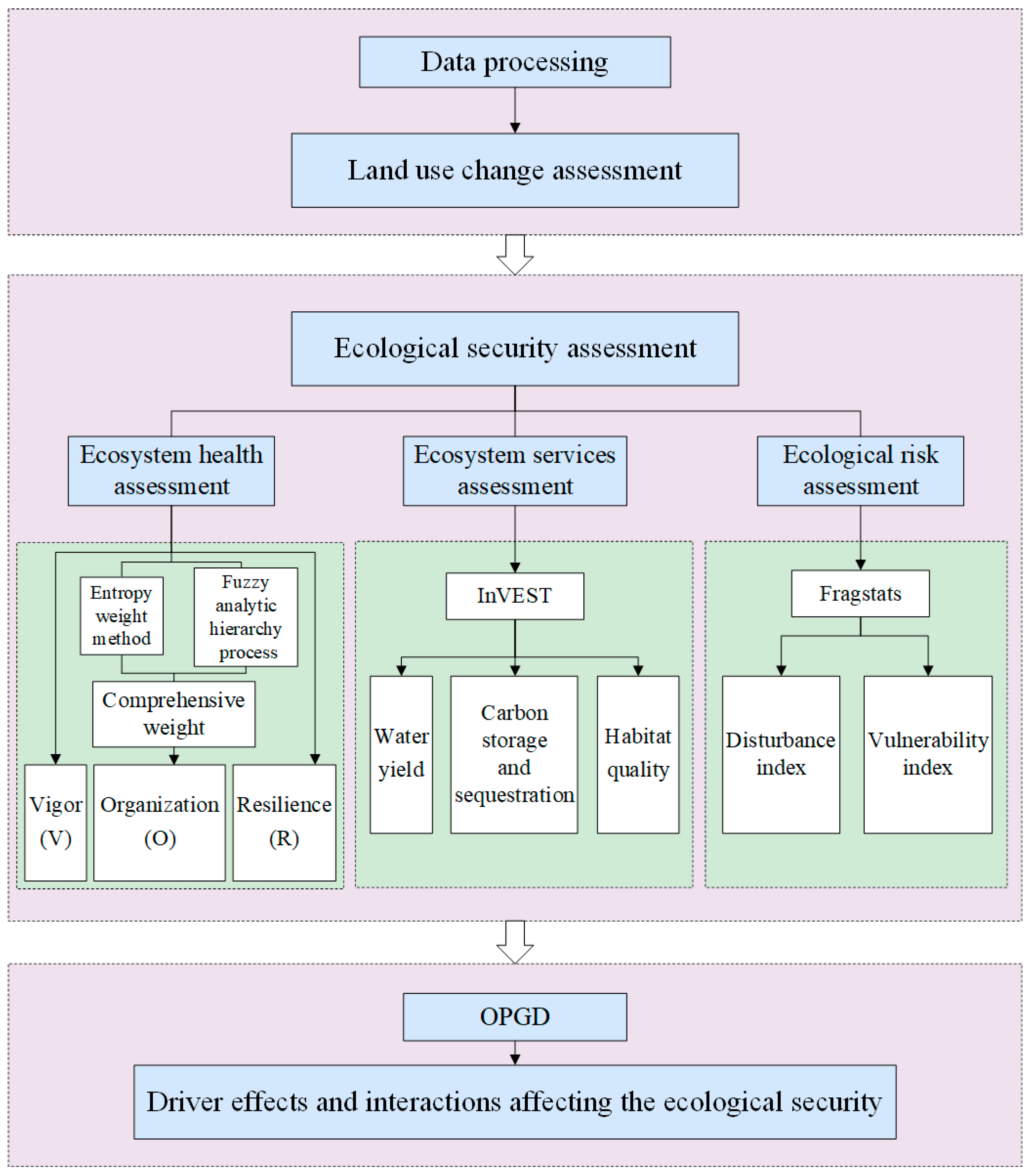
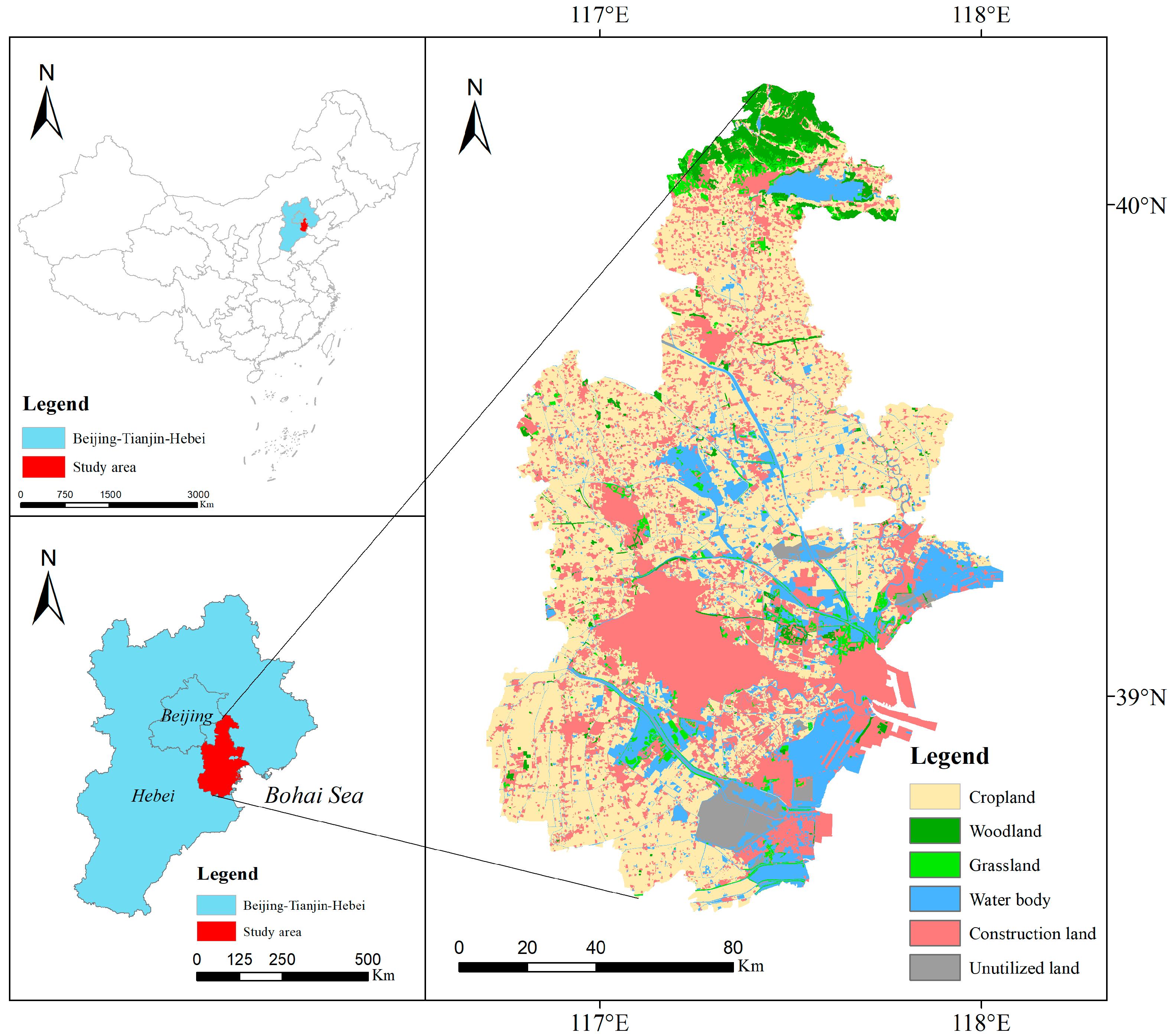
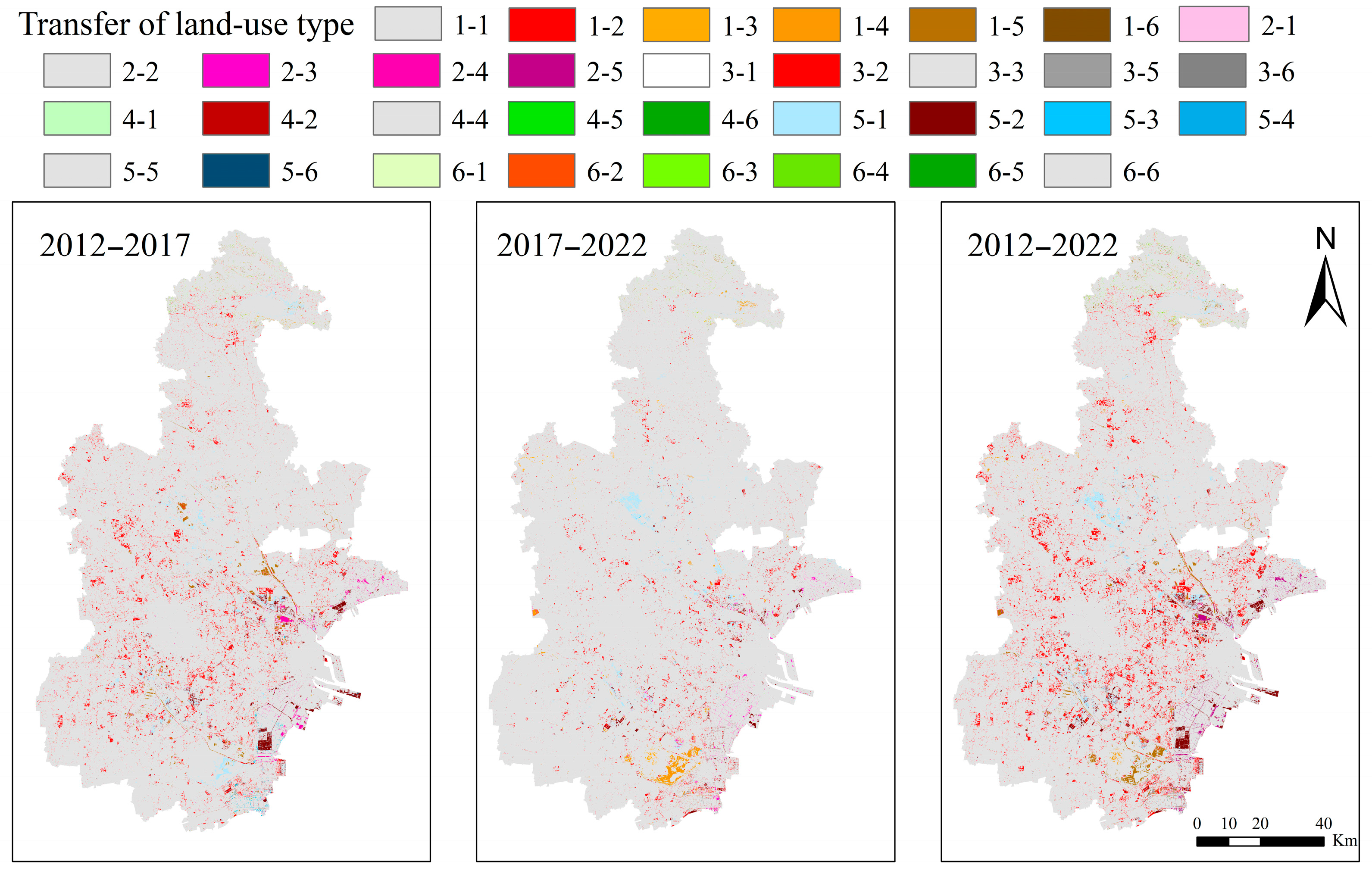
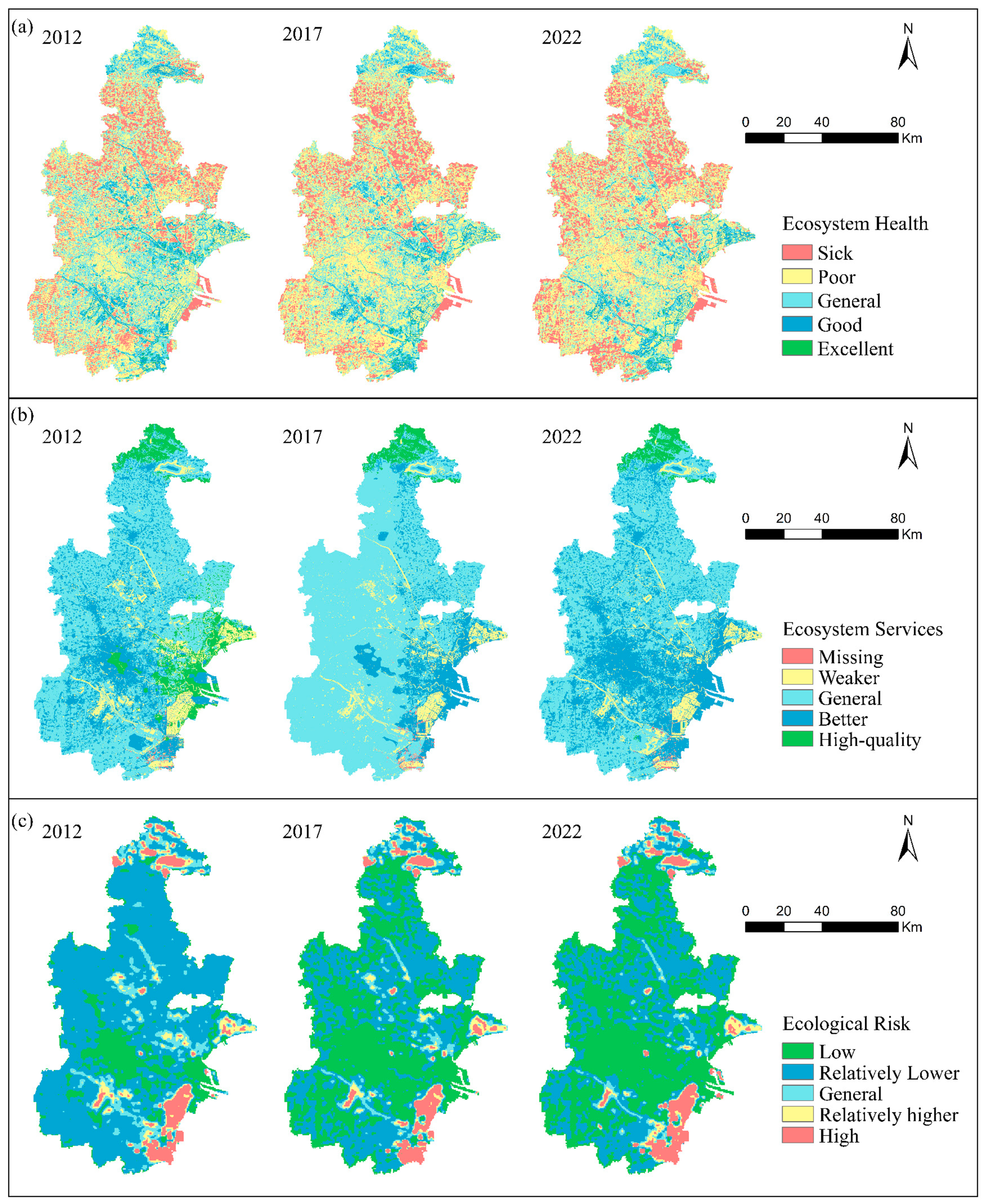

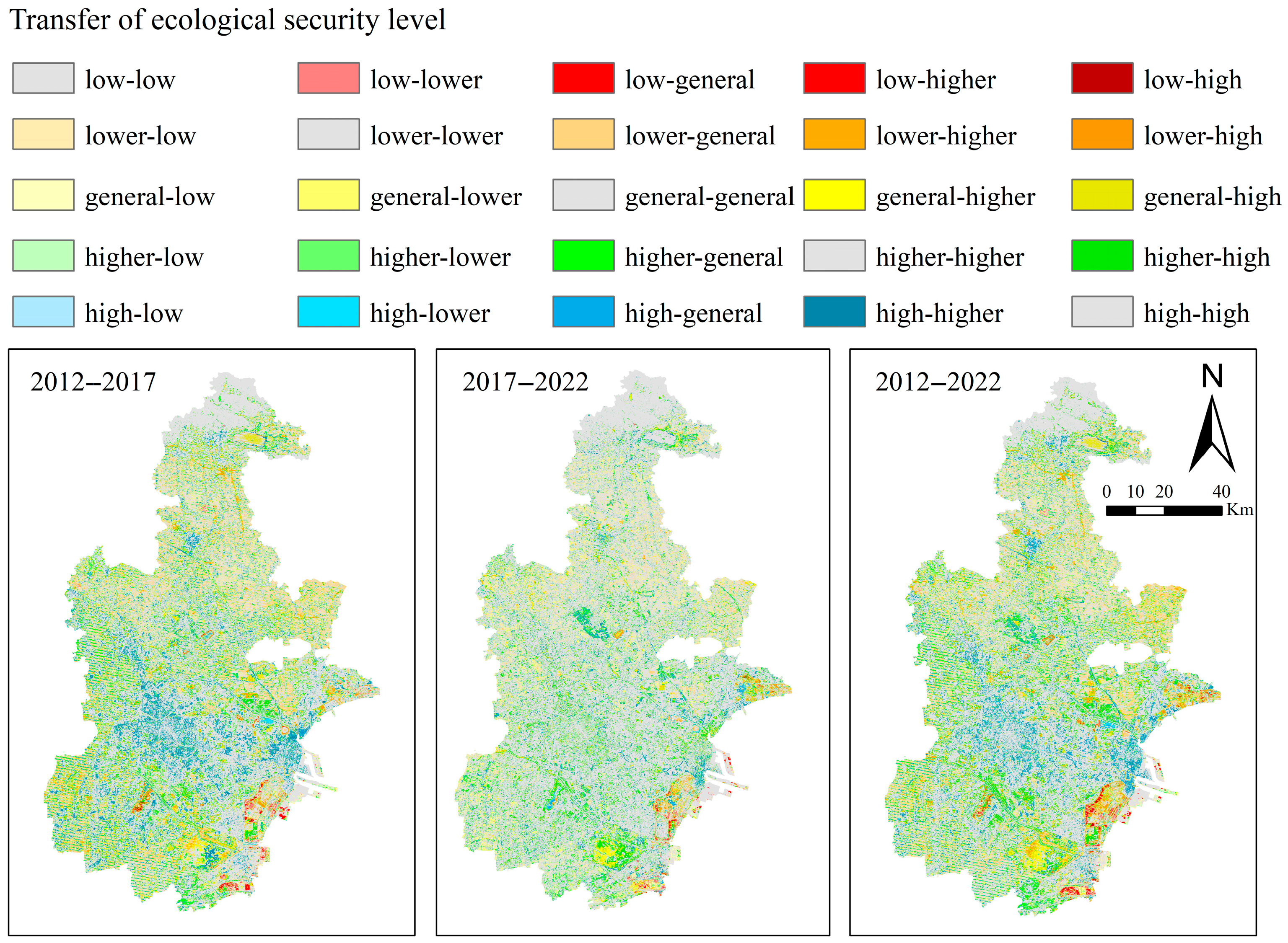
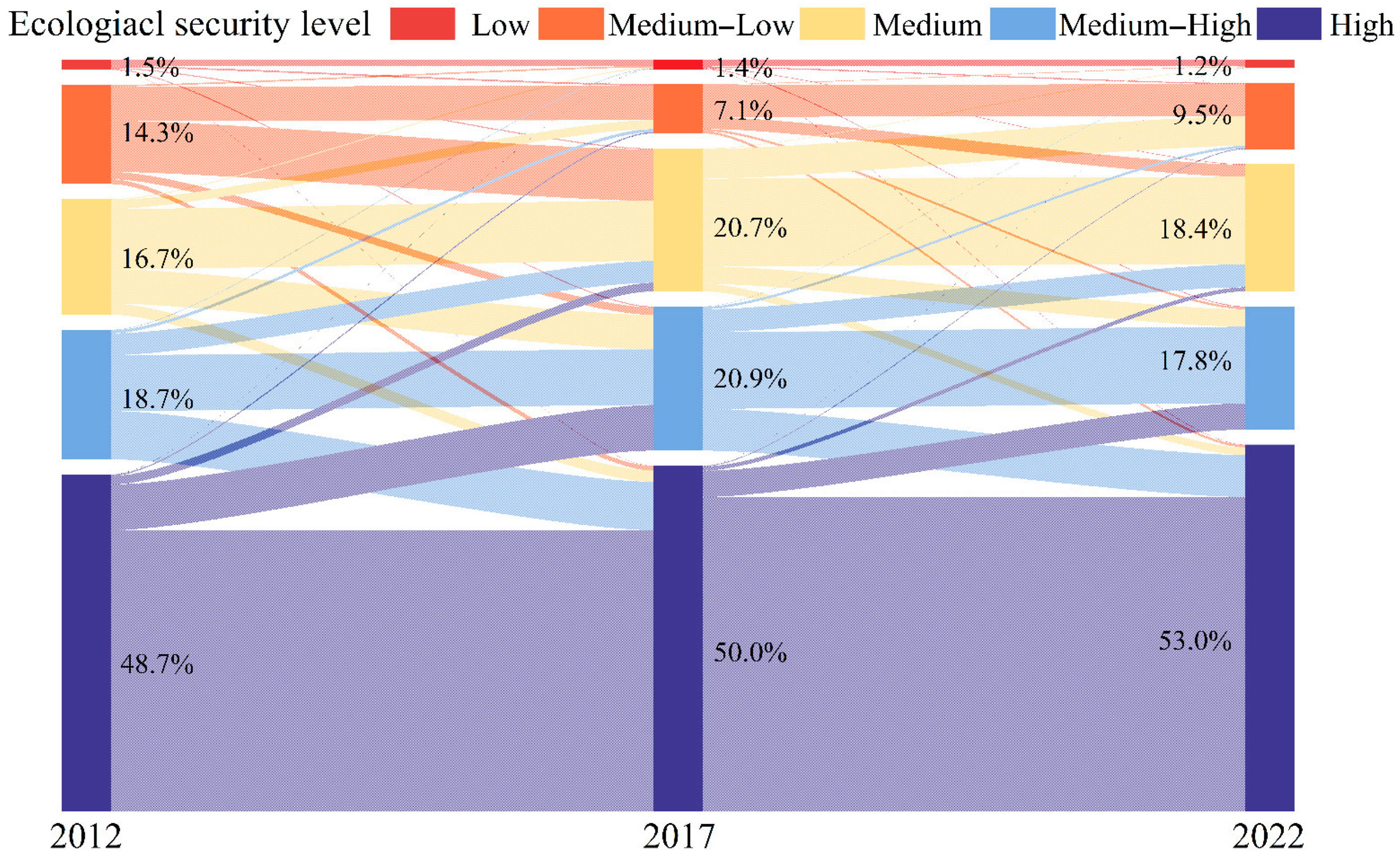

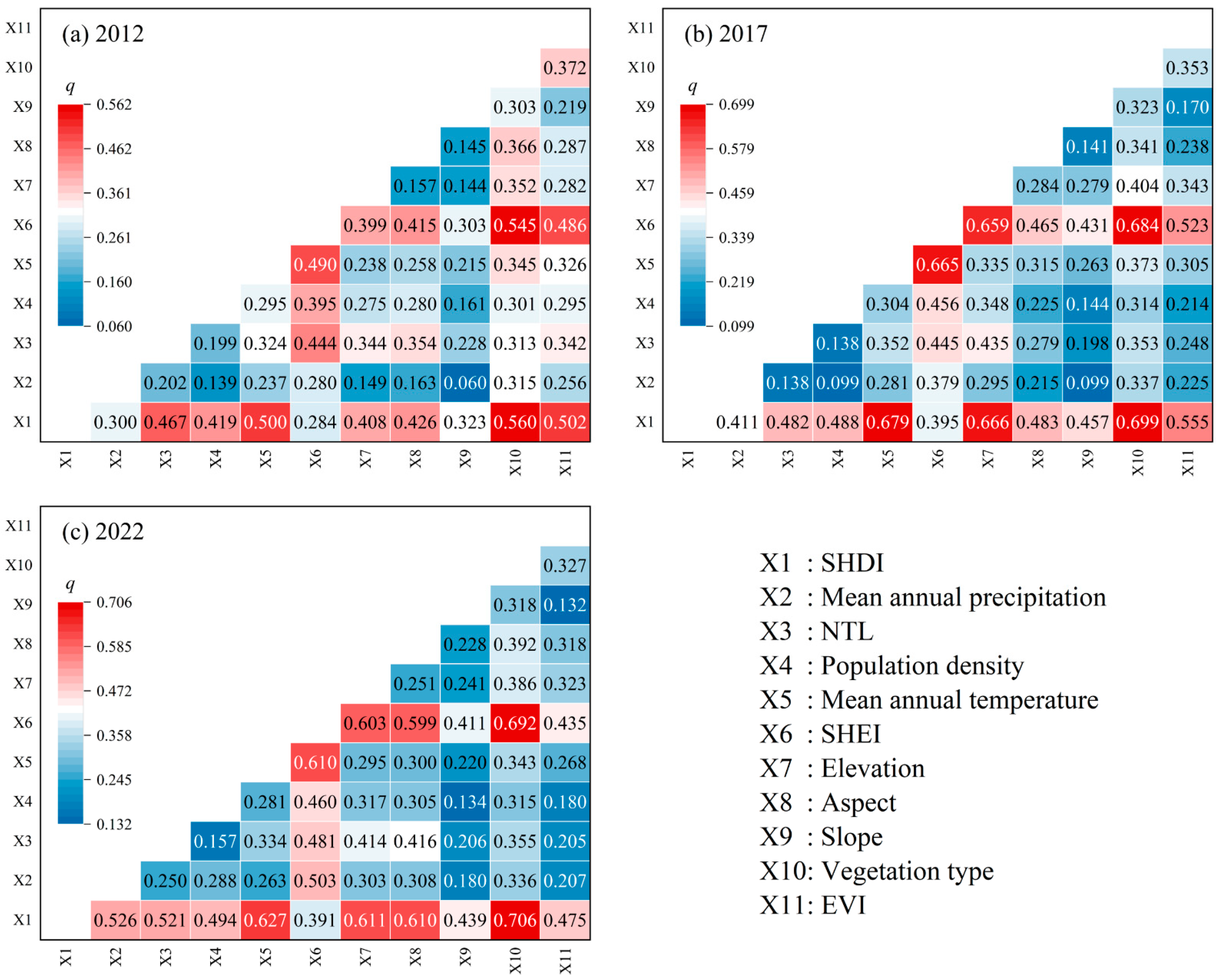
| Cropland | Woodland | Grassland | Water Body | Unutilized Land | Construction Land | Weights | |
|---|---|---|---|---|---|---|---|
| Resilience coefficient | 0.3 | 0.8 | 0.8 | 0.7 | 0.1 | 0.2 | 0.6 |
| Resistance coefficient | 0.5 | 1.0 | 0.7 | 0.8 | 0.2 | 0.3 | 0.4 |
| 2017 | ||||||||
|---|---|---|---|---|---|---|---|---|
| Cropland | Woodland | Grassland | Water Body | Unutilized Land | Construction Land | Total | ||
| 2 0 1 2 | Cropland | 6145.1 | 7.9 | 2.3 | 61.5 | 0.0 | 334.7 | 6551.4 |
| Woodland | 9.0 | 344.1 | 0.1 | 0.0 | 0.0 | 0.6 | 353.9 | |
| Grassland | 3.6 | 3.5 | 21.7 | 0.2 | 0.3 | 1.2 | 30.5 | |
| Water Body | 115.8 | 0.0 | 0.0 | 878.0 | 7.7 | 96.5 | 1098.1 | |
| Unutilized Land | 0.8 | 0.0 | 0.2 | 3.5 | 8.0 | 5.7 | 18.2 | |
| Construction Land | 0.7 | 0.0 | 0.0 | 42.4 | 0.2 | 3453.3 | 3496.5 | |
| Total | 6275.0 | 355.5 | 24.2 | 985.6 | 16.2 | 3892.0 | 11,548.6 | |
| 2022 | ||||||||
|---|---|---|---|---|---|---|---|---|
| Cropland | Woodland | Grassland | Water Body | Unutilized Land | Construction Land | Total | ||
| 2 0 1 7 | Cropland | 6036.9 | 12.2 | 3.8 | 64.1 | 0.0 | 158.0 | 6275.0 |
| Woodland | 14.8 | 340.0 | 0.4 | 0.0 | 0.0 | 0.3 | 355.5 | |
| Grassland | 3.9 | 1.5 | 18.6 | 0.1 | 0.0 | 0.2 | 24.2 | |
| Water Body | 107.7 | 0.2 | 0.0 | 828.5 | 0.3 | 48.9 | 985.6 | |
| Unutilized Land | 0.3 | 0.0 | 0.4 | 7.4 | 3.8 | 4.3 | 16.2 | |
| Construction Land | 0.6 | 0.0 | 0.0 | 27.5 | 0.0 | 3863.9 | 3892.0 | |
| Total | 6164.2 | 353.9 | 23.2 | 927.6 | 4.1 | 4075.6 | 11,548.6 | |
| 2022 | ||||||||
|---|---|---|---|---|---|---|---|---|
| Cropland | Woodland | Grassland | Water Body | Unutilized Land | Construction Land | Total | ||
| 2 0 1 2 | Cropland | 5962.5 | 15.8 | 4.4 | 86.1 | 0 | 482.5 | 6551.4 |
| Woodland | 19.1 | 332.9 | 0.9 | 0.1 | 0 | 0.9 | 353.9 | |
| Grassland | 6.1 | 5.0 | 17.4 | 0.4 | 0.1 | 1.4 | 30.5 | |
| Water Body | 172.2 | 0.1 | 0 | 782.4 | 1.9 | 141.5 | 1098.1 | |
| Unutilized Land | 0.6 | 0 | 0.4 | 6.3 | 1.9 | 8.9 | 18.2 | |
| Construction Land | 3.7 | 9 | 0 | 52.3 | 0.1 | 3440.4 | 3496.5 | |
| Total | 6164.2 | 353.9 | 23.2 | 927.6 | 4.1 | 4075.6 | 11,548.6 | |
| Type | Driving Factor | q in 2012 | q in 2017 | q in 2022 |
|---|---|---|---|---|
| Natural environments | Mean annual temperature | 0.1941 * | 0.2374 * | 0.1958 * |
| Mean annual precipitation | 0.0174 * | 0.0189 * | 0.1303 * | |
| Elevation | 0.1270 * | 0.2735 * | 0.2359 * | |
| Aspect | 0.1362 * | 0.0870 * | 0.2230 * | |
| Slope | 0.0372 * | 0.0706 * | 0.0587 * | |
| Human activity | Population density | 0.1095 * | 0.0619 * | 0.0633 * |
| NTL | 0.1777 * | 0.0926 * | 0.1103 * | |
| Ecosystem status | Vegetation type | 0.2691 * | 0.2901 * | 0.2915 * |
| SHDI | 0.2812 * | 0.3913 * | 0.3867 * | |
| SHEI | 0.2605 * | 0.3576 * | 0.3510 * | |
| EVI | 0.1932 * | 0.0997 * | 0.0498 * |
Disclaimer/Publisher’s Note: The statements, opinions and data contained in all publications are solely those of the individual author(s) and contributor(s) and not of MDPI and/or the editor(s). MDPI and/or the editor(s) disclaim responsibility for any injury to people or property resulting from any ideas, methods, instructions or products referred to in the content. |
© 2025 by the authors. Licensee MDPI, Basel, Switzerland. This article is an open access article distributed under the terms and conditions of the Creative Commons Attribution (CC BY) license (https://creativecommons.org/licenses/by/4.0/).
Share and Cite
Cheng, T.; Zhao, L.; Qiao, Z.; Yang, Y. Spatiotemporal Variation and Driving Forces of Ecological Security Based on Ecosystem Health, Services, and Risk in Tianjin, China. Sustainability 2025, 17, 6287. https://doi.org/10.3390/su17146287
Cheng T, Zhao L, Qiao Z, Yang Y. Spatiotemporal Variation and Driving Forces of Ecological Security Based on Ecosystem Health, Services, and Risk in Tianjin, China. Sustainability. 2025; 17(14):6287. https://doi.org/10.3390/su17146287
Chicago/Turabian StyleCheng, Tiantian, Lin Zhao, Zhi Qiao, and Yongkui Yang. 2025. "Spatiotemporal Variation and Driving Forces of Ecological Security Based on Ecosystem Health, Services, and Risk in Tianjin, China" Sustainability 17, no. 14: 6287. https://doi.org/10.3390/su17146287
APA StyleCheng, T., Zhao, L., Qiao, Z., & Yang, Y. (2025). Spatiotemporal Variation and Driving Forces of Ecological Security Based on Ecosystem Health, Services, and Risk in Tianjin, China. Sustainability, 17(14), 6287. https://doi.org/10.3390/su17146287







